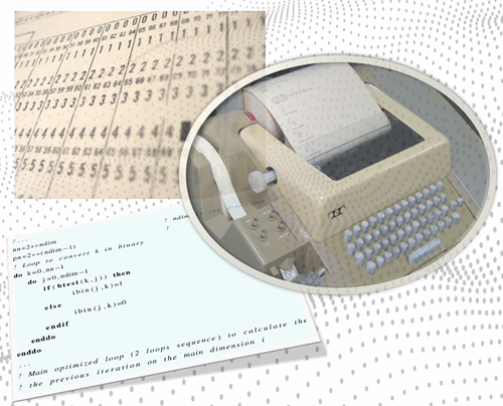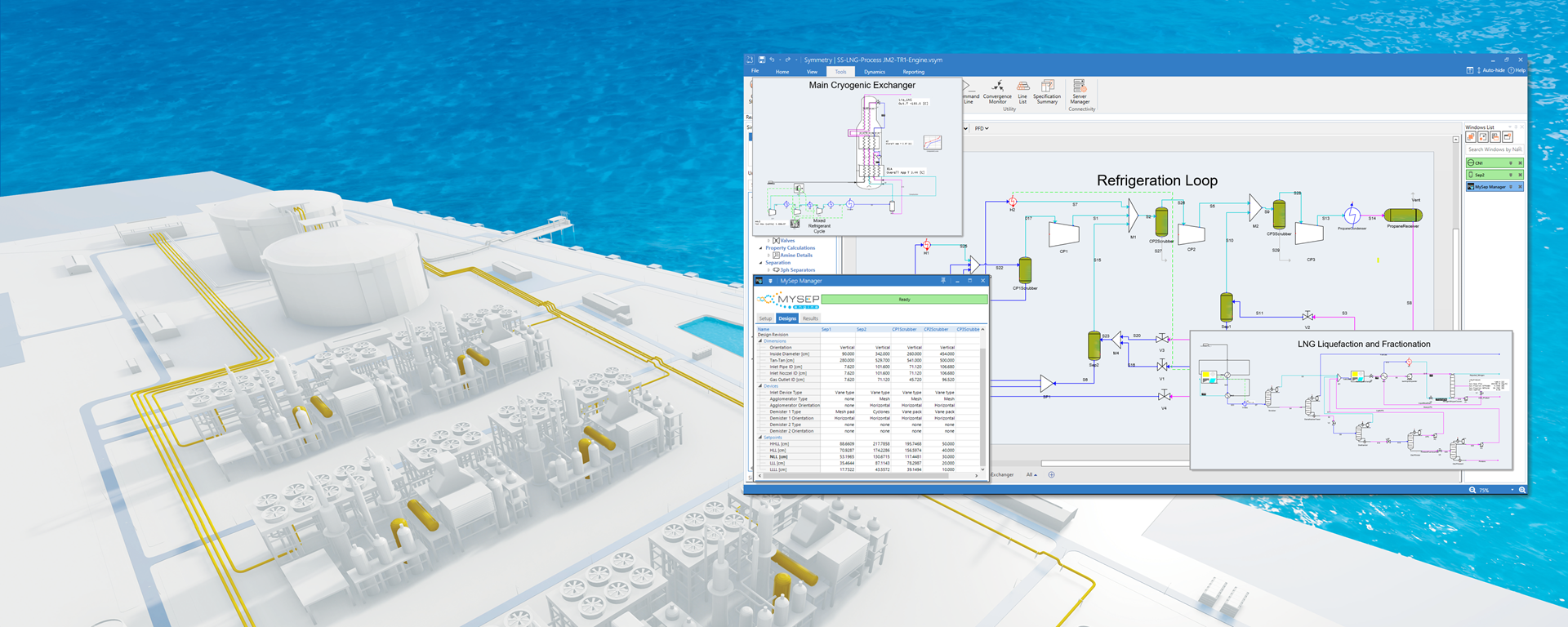Process Simulation
Process simulation is essential to the design and operation of processes. Often simulations are considered a Digital Twin of the actual process and used to explore operational strategies to optimize energy use, explore the impact of feedstock variation and demand-side trends to maximise the profitability of huge capital assets.
Introduction
In the oil & gas production, midstream transport and processing, refinery processing, petrochemicals, and bulk chemicals industry sectors, process simulation is a widely used software application. It is employed to optimize process designs and to provide a foundation for the design of key process equipment. Today, process simulation is also often deployed as a digital twin, to optimize process operations in the face of many challenges, including:
- Changing feedstock composition and flowrates
- Analysing the effects of process upsets
- Helping to devise control and operating strategies to achieve product specifications
- Minimizing energy consumption
- Assisting in tracking emissions to meet regulatory requirements and maximizing production profitability

Process Simulation History
The first process simulation software programs emerged in the 1960s, developed by large chemical companies such as Monsanto in the US and Imperial Chemical Industries in the UK. These programs were conceived to solve the heat and material balances necessary for designing complex industrial-scale chemical production processes. Many other chemical companies, as well as emerging process licensors, developed similar software.
In the 1970s, Aspen Plus and PRO/II were commercialized as batch-run simulation tools. These program calculations quickly evolved into complex iterative algorithms demanding significant execution time on the mainframe computers of the day. Initially used in chemical process design, their application scope soon extended to refinery operations and oil & gas production. Simulation technology began to be used in optimizing the design of highly integrated processes, such as key refinery process synthesis and distillation units, LNG production and air separation. This period marked a progressive shift from in-house simulation tools to licensed commercial process simulation software.
Desktop Computing and Process Simulation
The 1980s saw a revolution in computing technology with the emergence of desktop machines. The advent of the IBM PC and its Microsoft DOS operating system enabled more engineering calculations to be performed interactively. Hyprotech’s HISIM process simulator introduced the concept of a graphical user interface for developing process flow diagrams, coupled with the solution of flowsheet heat and material balances. As the Windows operating system replaced DOS, the Hyprotech HYSYS process simulator began to capture a significant market share, especially in the upstream oil & gas sector.
Eventually, all popular commercial process simulators were available on desktop computers and these adopted graphical flowsheets integrated with heat and material balance calculations. Fractional distillation modelling became pivotal in designing separation of chemical compounds, while reactor modelling and rate-chemistry simulations were essential for configuring the processes used to synthesize of important chemical products. Over time, additional critical process engineering design and simulation capabilities were incorporated, such as the sizing of pipelines, valves and equipment for key process unit operations.


Leading Commercial Process Simulators
There has been tremendous progress in the power and flexibility of process simulation programs. Most offer comprehensive thermodynamic and fluid property modelling, links to industry leading 3rd party modelling of unit operations and the ability to embed user developed models.
Today the leading commercial process simulators used worldwide include:
- Aspen HYSYS®
- AVEVA PRO/II™
- Honeywell UniSim Design®
- KBC Petro-SIM®
- Kongsberg K-Spice®
- SLB Symmetry®
Calculations and Solvers
Commercial process simulators use two primary types of solver schemes: sequential modular (SM) solvers and equation-oriented (EO)solvers.
In a sequential modular approach, the process flowsheet is broken down into individual unit operations (modules) that are solved one at a time. The output from one unit becomes the input for the next, making it easy to implement and understand, but it can be less efficient for complex systems with strong interactions between units. It requires a lot of iterations where recycled streams mean that upstream unit operations have dependency on downstream operations. One advantage of the SM approach is the ease with which complex, first principles physics-based unit operation models can be incorporated.
The EO approach solves all unit operation representations simultaneously, as a large system of equations. This method is more computationally intensive but is well-suited to very large models with highly integrated systems. Here interdependence between units are significant but the approach allows large systems to be solved and multi-variable optimization to be carried out efficiently.
Some of the commercial products offer both SM and EO modelling in a single software license and most offer.
Across industry, the ease of learning and ease of use has resulted in SM simulation being the most widely used approach.


Thermodynamics and Material Properties
In leading commercial process simulators, such as Aspen HYSYS, SLB Symmetry and AVEVA Pro/II, Honeywell UniSim Design and KBC Perto-SIM, chemical reactions and phase equilibria are typically modelled using a combination of mathematical and computational techniques. Some key aspects are as follows:
- Reaction Kinetics: These simulators use detailed kinetic models to describe the rates of chemical reactions. This involves specifying the reaction mechanisms, rate constants, and the influence of temperature and pressure on reaction rates.
- Thermodynamic Models: Accurate thermodynamic models are essential for predicting the behaviour of chemical species in different phases. These models help in calculating properties like enthalpy, entropy, and Gibbs free energy, which are crucial for stream phase equilibrium, fractionation and reaction equilibrium calculations.
- Mass and Energy Balances: Simulators perform rigorous mass and energy balance calculations to ensure that all material and energy inputs and outputs are accounted for. This helps in understanding the overall efficiency in terms of product compositions and feasibility of the process.
- Multi-phase and Multi-scale Modelling: Advanced simulators can handle multi-phase systems (e.g., gas-liquid, liquid-solid) and multi-scale modelling, which integrates phenomena occurring at different scales, from molecular to macroscopic levels.
- Fluid Dynamics and Transport Phenomena: These tools often include modules for simulating fluid flow and transport phenomena within reactors, heat exchangers, pumps, compressors, pipe systems, distillation columns and process phase separators.
MySep Software and Process Simulation
can extract process data for the feed stream of target separators, from live simulations with: Aspen HYSYS®, AVEVA PRO/II™, Honeywell UniSim Design®, KBC Petro-SIM® and SLB Symmetry®. This allows a process engineer to analyse the separator performance of any separator in detail. Where the source simulation represents an operating process, this facilitates identification of system bottlenecks and exploration of remediation strategies. During Conceptual Design, FEED or Detailed Design projects, MySep Studio brings proper separator design practice, coupled with assured performance prediction.
To deploy separator models in a process simulation with MySep Engine, the MySep Studio application provides comprehensive capabilities to build representative separator models and to save these in a specially configured file, with the extension ".myg" .
In addition, MySep Studio can also update the vapour product stream for separators in simulations, with liquid carry-over in vapour, and provide the correct unit pressure drop.
Application Examples:
- Short tutorial video on importing process data from a simulator into MySep Studio (demonstrated with HYSYS but typical of any of the simulators supported): https://www.mysep.com/latest-tutorials#import-from-simulation
- Troubleshooting case study with MySep Studio: https://www.mysep.com/case-studies-and-downloads/troubleshooting-gas-compression-system


embeds MySep’s rigorous gas-liquid separation modelling in active process simulations of Aspen HYSYS®, AVEVA PRO/II™, AVEVA™ Dynamic Simulation, Honeywell UniSim Design®, KBC Petro-SIM®, Kongsberg K-Spice and SLB Symmetry®. MySep Engine is fully functional with the simulators in steady state and dynamic applications.
The MySep Engine module can model any number of separators in a process simulation, with MySep's full gas-liquid separation modelling and proprietary correlations. It provides for pre-configuration of separators via the ".myg" file, and once individual separator geometries are mapped onto their appropriate simulator separator unit operations, the geometries are saved with the native simulator file.
Application Examples:
- The value of MySep Engine in a process digital twin, video summary: https://www.mysep.com/mysep/latest-videos#margin-optimization-
- MySep Engine and MySep Studio, applied with KBC Perto-SIM, to optimization of a refinery FCC wet gas compression system, KBC and MySep jointly publish a white paper: Digital twin optimises FCC operations for real separator behaviour: Petroleum Technology Quarterly (PTQ), Q2 2022, P27-31
MySep Engine and MySep Studio embedding & links to optimize an LNG process refrigeration system: https://www.mysep.com/case-studies-and-downloads/digital-twin-tackles-lng-separation-challenge
- Video overview of how MySep software works with simulators (Example with HYSYS but work flows are typical of those with all supported simulators): https://www.mysep.com/mysep/latest-videos#aspen-hysys-and-mysep

